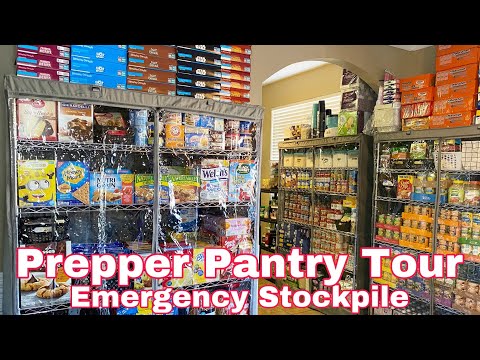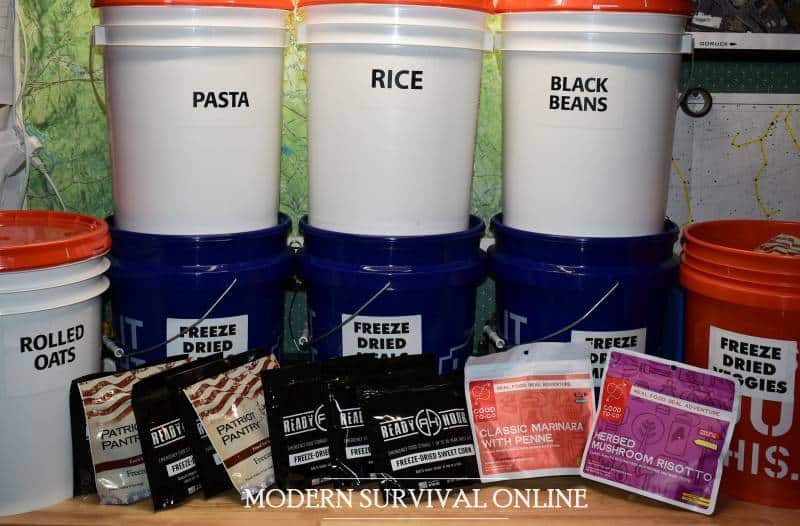If you want to be prepared to survive the aftermath of a disaster, a societal collapse or just the ups and downs of life in these increasingly turbulent and uncertain times you must have a stash of necessities. One of the most important provisions that any prepper will accumulate is food.
Sure, compared to shelter and water the need for food might not be so pressing. You can only go a few hours without shelter and bad conditions, and a few days without water before you kick the bucket, but you can go weeks or even more than a month without food and survive.

But even though you can survive, things will steadily get worse and worse until you are unable to affect self-rescue and eventually die of starvation.
Food is fuel, and you’ll need plenty of it if you want to survive. But despite all the advances brought about for prepping methodology in the internet age several factual errors and nasty myths persist and propagate concerning food storage.
We are here to do our own version of Mythbusters in this article, and I’ll be dissecting seven of the worst food storage myths that you should not fall prey to!
Lie #1: “You Cannot Afford to Create a Stockpile of Food.”
This is one of the most common myths that I see beginning or would-be preppers get taken by regarding food storage.
They see their neighbors’ or their relative’s huge stockpile of food arranged neatly on banks of shelves in a dedicated emergency pantry and all they can think of is how much it must have cost to put all that together. This is totally understandable, but misguided.
Accumulating a worthy stash of food that you can survive on when times get rough is not a matter of going out and buying an additional two or three months worth of groceries in one shot, though that might be an option for some people.

You can begin right now, today, by buying just one or two extra items every time you make a trip to the store, and then storing these items appropriately.
The next time you grab some canned peaches, grab another can to add to your stash. When you swing out to grab some milk from the grocery get some powdered milk for your stash.
Small, painless incidental purchases will quickly add up until you have a 3-day supply, then week supply, then a 1-month supply and so on. Before long you’ll be ready for the long haul with a 3- or 6-month stash!
Lie #2: “You Can Totally Trust the “Expiration Date” on the Package.”
More than most other food storage myths the amount of misinformation, lie, falsehood, and folklore that surrounds the humble expiration date is stunning.
Present on virtually every, single item we buy from the grocery, as it turns out, your typical expiration date might not be an expiration date at all: It could be a “best by” or “sell by” date that is a guideline, at best.
Plenty of foods, if properly stored and uncontaminated, are good well past that printed date on the package.

Other foods might have highly variable shelf lives depending on how and where they are stored. Still others have a frankly indeterminate shelf life and you might only be able to trust them after careful inspection or preparation.
There is way, way too much on the subject to get into here, but suffice it to say that you should trust your own experience, observations and initiative when making a determination on whether or not food is good, dodgy or obviously unsafe to eat after being stored.
Lie #3: “Bad” Food Will Change Color, Texture, Odor or Taste.”
This myth piggybacks off the previous one. Common wisdom suggests that food that has gone bad will change or otherwise indicate this status somehow.
Maybe it smells bad, maybe it will look different, the texture, shine or color will change and, if we get that far, surely it will taste different. Right? Right.
Not so fast, there: It is true to say that food that has undergone any or all of these changes has likely gone bad, but food that has gone bad may not necessarily undergo any or all of these changes.
As it turns out, the bacteria of decomposition or other contamination could be present in food that has gone bad but not yet had time to significantly disrupt the typical appearance or other characteristics of food. This means those delicious canned tamales you love so much might look, smell and taste just as good as normal but be harboring a bacterial threat that is going to crush you with gastrointestinal distress.
The point is, for survival purposes you’ll really need to be on your toes. You should be highly suspicious of any food with compromised packaging, even if it appears completely normal. Take care when preparing food that you cook it thoroughly and extremely well, as this will kill lurking bacteria. If you are dealing with food that you know has been in storage for an extremely long time, use caution.
Lie #4: “Once You Get So Much Food, You Can Stop.”
This is another common food storage fallacy that preppers are particularly vulnerable to. There is a notion that once you create your checklist, or shopping list, for your emergency food storage stash you can simply “quit the program” once you have checked everything off of said list. That’s it, you’re good! You’re finally “prepared”! This is, sadly, just not true.
You’re probably heard it said that prepping is a journey, and nowhere is this truer than when it comes to food storage. Simply stated, you can never, ever sit on your hands and just stop. Even after you accumulate a certain quantity of food your work will never end.
Food must be rotated regularly, inspected periodically, and replaced when necessary. Accumulating everything on your list and then sitting on your hands waiting for the bombs to fall means you’ll have tons of spoiled, useless food when and if that fateful day arrives.
Your food won’t last forever, no matter how it is prepared or preserved, and that means you must constantly, incrementally be replacing your stocks. That’s just the way it is.
Lie #5: “Dry Beans and Grains Never Go Bad.”
Some preppers, particularly those of an old school or minimalist bent don’t like to mess around with stocking and stashing all of the many different cans, pouches and tubs full of food that embody modern, off-the-shelf provisions today.
Instead, they go back to basics and plan on stocking the staples alone, particularly dried beans and various grains.
The idea is that these simple, wholesome foodstuffs are basically impervious to degradation and subsequent decomposition that so plagues our modern processed and wet foods.
Regrettably, these foods do not last forever and indeed might be more vulnerable to spoilage than other options in certain conditions.
Though beans do not typically decompose when stored dry in correct conditions they are notorious for getting harder and harder over time until you basically cannot cook them. There are reports of old or vintage beans refusing to soften even in a pressure cooker.
Grains are not much better, as they will break down over time until they are essentially dust and will remain vulnerable to infestations of various insects and arthropods for their entire shelf life.
As it turns out, you can never outrun or otherwise “cheat” the requirement of inspecting and rotating your food stores regularly.

Lie #6: “Freeze-Dried Emergency Meals are all You Should Buy.”
In stark contrast to the above myth, some preppers steer into modern options for food storage, choosing to stockpile hundreds of pounds of freeze dried emergency meals in those ever popular, heavy duty plastic tubs.
Many of these products are marketed specifically towards preppers and other personal readiness adherents and are often touted as having a shelf life measured in years with absolutely no care required.
While that may be true and freeze dried, preserved and vacuum packed emergency meals might indeed be king of the hill when it comes to shelf life, they are not the one, true solution for an emergency food stash.

There is always a catch, and the catch for freeze dried food is it requires a tremendous amount of water just to prepare.
This, as you might expect, will increase dramatically the amount of water you must keep on hand, fresh and ready to use, if you want to rely on this freeze-dried food that you have bought. This can be a logistical strain out of all proportion with the availability of the crucial ingredient.
Not for nothing, these freeze dried foods are often full of additional chemical preservatives and absolutely jam-packed with salt, which will in turn make you thirstier and crave even more water…

Lie #7: “You Can Keep Your Stored Food Wherever You Can Fit It.”
Not everyone enjoys the same lifestyle or living arrangements as everyone else, and for some preppers storage space is at a decided and highly priced premium. This means that unconventional storage spaces must be found, converted or otherwise utilized for the storage of this emergency food stash.
Articles abound on the internet advising those of us living in cramped confines where we can stash our food, and while genuinely helpful they often omit the pertinent factors that dictate what food can be stored safely where, and for the longest amount of time.
Failing to take individual food storage requirements in account will lead to increased spoilage, wasted money and certainly increased effort as inspection and rotation frequency will be increased.
You shouldn’t keep dehydrated or canned food where you keep fresh vegetables or bulk grains and beans. Not necessarily, as depending on the item in question the requirements could be very different.
Of course, you can only do what you can do but this is something that must be kept in mind if you want your stash to last as long as it can.
Conclusion
We all started out somewhere, and no one has all the answers, but when you want to get a jump on doing anything right it is often more instructive to avoid making the biggest and most common mistakes.
When it comes to assembling and storing your emergency food stash the above seven myths are some of the most prevalent, and potentially the most destructive. Make sure you learn what they are, commit them to memory, and strive continuously to avoid them!

via Modern Survival Online https://ift.tt/3ycMWvR
No comments:
Post a Comment